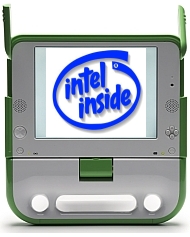
I'm sure everyone has seen Sumner Lemon's article about Intel inside One Laptop Per Child. In reading his comments on the previously reported effort of Intel to be OLPC's chipset supplier, I was intrigued by Walter Bender's take-all-comers comment of:
"Intel, like a lot of other people, is more than welcome to try to design great silicon for this project and this mission, and we've been working with them to help them do exactly that."Such bravado reminds me of the original OLPC mission, since changed, that said they were open to others producing a low-cost laptop too. But this time it may be different. Joel Hruska reports that One Laptop Per Child should be ready to change chipsets soon:
In short, the OLPC XO is currently running on a CPU core that doesn't even qualify as a 5th-generation Pentium-class CPU. Intel, in contrast, is talking about building an OLPC system based around either modified Celeron processors or the upcoming dual-core Silverthorne, built on a 45nm process. The company seems to think it can do this in a cost-effective manner.Now "cost-effective" would be the operative phrase as rumors have Intel's design being either modified Celeron M's (A100 or A110) or the new Silverthorne processor for ultra mobile computers (UMPC's), neither of which can currently match the AMD Geode in price or low-pow performance.
Either way, the XO-2 design will be different from the XO-1, and maybe radically so. While the current "$100 laptop" design is perfect for high-heat, high-dust, low-electricity environments, Walter Bender is thinking big.
Probably thinking exactly along the lines of Mary Lou Jepsen's OLPC product roadmap that includes a whole quiver of low-power computing XO spin-off products.
But until we have a XO-2, or XO-1 in full production for that matter, I have to agree with Christopher Dawson's conclusion on the Intel vs. everyone battle for XO chipsets:
This degree of competition [between chip makers for OLPC orders] certainly bodes well for this segment of the [education] market, both domestically and abroad. With attention turning away from simply ramping up clock speed to reducing power consumption and increasing mobility at very low costs, even kids in the states should feel the ripple effect from this ongoing rivalry.Oh yeah! May this be the end of bloatware and the beginning of real developing world technology exploration.



you'd think that bringing in intel would mean more competition, better, cheaper, etc.
but intel hates competition. thats why they've been convicted in japan, and have pending inditements in korea and the EU. anti-compeititive business practices. like how they paid japanese pc makers 100's of millions to stop using amd! thats what the JFTC said.
they're main goal here is to take this contract away from AMD. they'll do that at the expense of making any sort of money, because a dollar spent that costs amd 2 dollars is a good deal for them. once they use their brute force and mafia tactics to take this market, it will stagnate.
Does it matter what "class" the CPU belongs to ? Surely the cost effective delivery of functionality is the key requirement, not some anorak's definition of the CPU capability.
PhilT,
I agree. It doesn't matter what phylum, class, or genus the chipset belongs to as long as it matches or exceeds the current power/performance mix of the AMD Geode. And if I had a preference, I'd want more efficiency (less power for current performance) over other factors.
i need a laptop for some research program
im student
i want to do some thing more in computer sciences
i want to make the world more wonderful
Digitimes says Intel will power OLPC's XO-2, maybe:
The three major low-cost notebook initiatives, Classmate PC by Intel, Eee PC by Asustek Computer and OLPC (one laptop per child) by Massachusetts Institute of Technology (MIT) are planning to push out second-generation models next year and will all adopt Intel's Menlow platform, according to a Chinese-language Commercial Times report citing John Davies, vice president of World Ahead for Intel as saying.
As for the OLPC, Davies pointed out that the delay is due to increasing NAND flash prices. With the material cost increase, OLPC's quote was recently reported to increase from US$176 to around US$190, added the paper.
http://www.digitimes.com/mobos/a20070920PB200.html